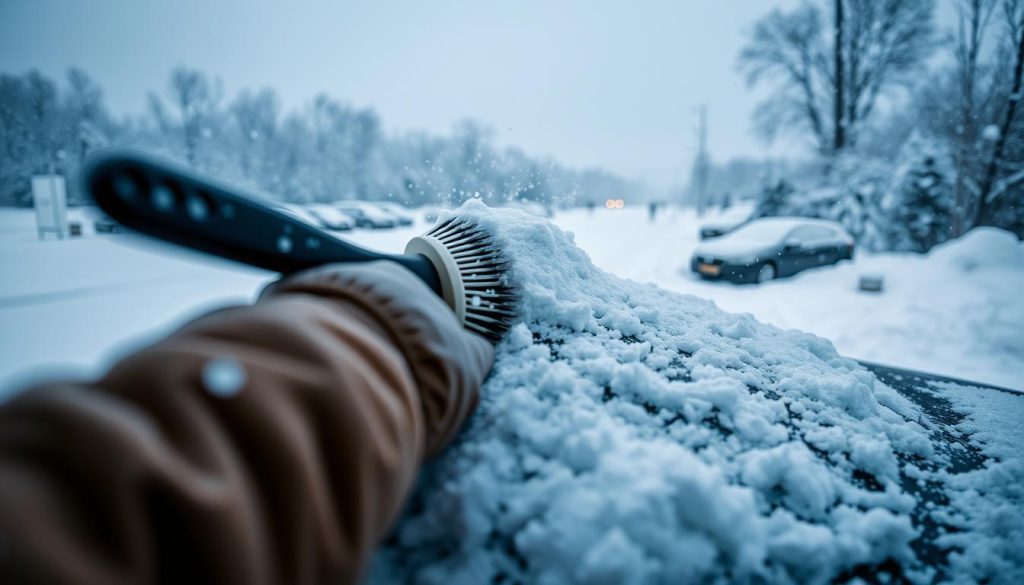anxietywhendriving.com highly recommends The Driving Fear Program to overcome your Driving Anxiety 90 Days Money Back Guarantee!
-->Click Here<--

A shocking 9% of American adults have a fear of snow, known as chionophobia. For Amy Andrews, this fear is extreme. Just hearing about snow can make her panic. Living in New England, where snowfall is heavy, her fear makes everyday tasks hard. She often misses work and cancels plans when snow is forecasted.
Driving in the snow is risky, with snow, ice, and whiteouts causing accidents and leaving drivers stranded. Yet, many try to face their fears to fear of driving in snow, winter driving tips, and snow driving techniques. This article will help you beat your driving anxiety, ensure safe winter driving, and gain the winter driving confidence needed to tackle tough conditions.
Key Takeaways
- Understand the root causes of chionophobia, the fear of snow, and how it can impact winter driving.
- Prepare your vehicle with the right equipment, including winter tires, to improve handling and safety on icy roads.
- Develop snow driving techniques like looking ahead and increasing following distance to adapt to the changing conditions.
- Build winter driving confidence through preparation and practice, seeking professional help if necessary.
- Conquer your fear of driving in snow one step at a time, prioritizing safety and resilience.
Understanding Chionophobia: The Fear of Snow
Chionophobia is a fear of snow that can greatly affect someone’s life. It’s more than just not liking snow or being scared of bad weather. It’s an irrational fear linked to the fear of death or getting hurt.
What is Chionophobia?
Chionophobia means fearing snow, which is a type of environmental phobia. These phobias are common and can come from many things. Past bad experiences, feeling out of control, or believing snow is a big threat can cause it.
Types of Fears Associated with Snow
- Fear of becoming snowbound: People with chionophobia might panic about being stuck at home or in a car because of snow.
- Fear of being stranded in snow: Being stuck in the snow, especially in a place far from help, scares some with chionophobia.
- Fear of injury or illness: Some fear the cold and worry about getting frostbite, hypothermia, or other health problems from the weather.
- Fear of driving in snow: Driving in the snow can make people with chionophobia very anxious. They might worry about losing control or getting into an accident.
Chionophobia can make people feel their heart race, shake, have trouble breathing, feel sick, and feel like things aren’t real. Just hearing about a winter storm can make these feelings worse.
“Chionophobia is not just a dislike of snow or a rational fear of severe weather forecasts, but an irrational fear of snow that is typically linked to a fear of death or bodily harm.”
To beat chionophobia, it’s important to understand what causes it and what fears it brings. This can help people feel more confident in winter.
Preparing Your Vehicle for Winter Driving
As winter comes, making sure your car is ready for the cold is key. One vital step is putting on winter tires. These tires are made to give your car better traction and grip on snow and ice. This means your car will stop and speed up faster in the cold.
Winter tires have a softer rubber that stays flexible in the cold. This lets the tire tread hug the road better, giving you great tire grip. It helps your car stay on the road and avoid slipping on icy surfaces.
The Importance of Winter Tires
- Improved traction and grip on snow and ice
- Shorter stopping distance in winter conditions
- Better acceleration from a standstill
- Enhanced stability and control in challenging weather
Putting winter tires on your car is just the start. Make sure to clear your car of snow, ice, and frost before driving. Clearing all windows, mirrors, headlights, and taillights is key for good visibility. This helps keep you and others safe on the road.
| Tires | Grip on Snow | Braking Distance | Acceleration |
|---|---|---|---|
| Winter Tires | Excellent | Shorter | Better |
| All-Season Tires | Good | Longer | Average |
| Summer Tires | Poor | Longest | Worse |
Getting your car ready for winter driving takes time and effort. But, it gives you the confidence and peace of mind you need to face the cold months ahead.
Clearing Your Vehicle for Optimal Visibility
Before you drive in the winter, make sure your car is ready for clear visibility. Start by removing all snow, ice, or frost from the windows, mirrors, headlights, and taillights. This makes sure you can see what’s around you and that others can see your car.
While cleaning the outside, remember to start the engine. Let the defroster and fan work to clear the windshield from inside. This makes seeing the road much better from your seat.
- Brush off all snow and ice from the windows, mirrors, headlights, and taillights
- Turn on the engine and use the defroster and fan to clear the windshield
- Make sure all lights are functioning properly for optimal visibility
By spending a bit of time to clear your vehicle before you go, you’ll greatly improve your winter driving preparation. This simple action boosts your visibility on the road. It’s a key step for a safe and confident drive, even when dealing with lots of snow and ice removal.

“Visibility is the key to safe winter driving. Clearing your car of snow and ice is the first step to ensuring a smooth and confident journey.”
Dressing Appropriately for Winter Driving
When you’re driving in winter, what you wear can really affect your safety and comfort. Picking the right winter driving attire is key to keeping control of your car and having a smooth drive.
Many drivers make the mistake of wearing big, warm coats for winter. These coats might keep you cozy outside, but they can make moving your arms hard. This makes it tough to steer and use the pedals well. Instead, go for lighter clothes that let you move freely.
- Wear a sweater or thin jacket that won’t restrict your arm movements.
- Avoid thick boots that can make it hard to press the gas and brake pedals right.
- Keep your heavy winter boots in the trunk and wear thinner shoes or boots while driving.
By dressing right for winter driving, you can keep better control over your car and stay safe. The aim is to stay warm but still be able to drive well.
| Attire to Avoid | Recommended Attire |
|---|---|
| Bulky winter coats | Lightweight layers like sweaters |
| Thick-soled boots | Thinner-soled shoes or boots |
| Clothing that restricts range of motion | Flexible, unrestrictive clothing |
Being careful with your winter driving attire can boost your control and confidence on the road. This helps you safely get through winter driving challenges.
“Dressing for winter driving is more than just staying warm – it’s about maintaining the control and responsiveness you need to handle the conditions safely.”
Driving Techniques for Winter Conditions
As winter comes, it’s key to change how you drive for the tough weather. Learning these skills lets you safely drive through snow, ice, and heavy rain. This keeps you and others on the road safe.
Looking Ahead and Changing Lanes Early
Looking at least two blocks ahead is a vital winter driving tip. It helps you see brake lights or cars moving to another lane early. Change lanes early to dodge dangers and keep traffic moving smoothly.
Increasing Following Distance
It’s also important to increase your following distance. Instead of the usual two-second gap, try for a four-second gap. This gives you time to brake slowly and safely on slippery roads, lowering the risk of losing control.
Using these winter driving techniques, like looking ahead, changing lanes early, and increasing following distance, improves your control over your vehicle. It helps you make smart choices for the weather. Remember, staying alert and adjusting your driving to the road conditions is key to safe winter driving. Check out this link for more tips on overcoming fear of bad weather driving.
Overcome Fear of Driving in Snow
Many people find driving in snow scary, but you can beat this fear. By getting your car ready, dressing right, and learning how to drive in snow, you can gain confidence. This will help you face your chionophobia – the fear of snow.
Understanding why you’re anxious is a big step. Learn about the physical and mental for your fear. This knowledge can help you find ways to handle your feelings and reactions when driving in snow.
- Get to know how your car does in snow, like how your winter tires and deicing systems work.
- Practice driving in snow in a safe place, slowly getting used to the challenges to build your winter driving confidence.
- Change how you drive to fit the snow, like leaving more space between cars and being careful when switching lanes.
- Work on any negative thoughts about driving in snow, replacing them with positive and strong beliefs.
By facing your driving anxiety and actively preparing and improving your winter driving skills, you can beat your fear of driving in snow. This will let you safely enjoy driving, even when the weather is tough.
“Overcoming the fear of driving in snow is a journey, but with the right mindset and the proper preparation, you can conquer this challenge and regain your confidence on the road.”
| Strategies for Overcoming Fear of Driving in Snow | Benefits |
|---|---|
| Understand the causes of your anxiety and develop coping mechanisms | Helps manage emotional and physiological reactions during winter driving |
| Familiarize yourself with your vehicle’s winter capabilities | Builds confidence in your car’s performance in snow |
| Practice driving in snowy conditions gradually | Develops winter driving skills and boosts winter driving confidence |
| Adjust driving techniques for safety | Helps you navigate winter roads more effectively and confidently |
| Address negative thoughts and beliefs about winter driving | Cultivates a positive and empowered mindset to overcome fear of driving in snow |
Leaving Early and Avoiding Severe Weather
When driving in winter, leaving early and avoiding severe weather are key. Planning ahead and adjusting your travel plans can help reduce stress and anxiety. This makes navigating icy roads less daunting.
Leaving early helps you avoid delays from winter weather. It lets you reach your destination without feeling rushed or anxious about the time. This is crucial if you face unexpected snow, icy spots, or poor visibility.
It’s also vital to keep an eye on the weather forecast. If severe weather is expected, consider not driving. Instead, use public transport or delay your trip. Putting your safety first is more important than being on time.
- Plan your route and leave early to account for potential delays
- Monitor weather forecasts and avoid driving in severe conditions
- Consider alternative modes of transportation if the weather is particularly treacherous
By being proactive, you can reduce the fear and anxiety of winter driving. Leaving early and avoiding severe weather are key to making winter driving safer.
The Role of Confidence in Winter Driving
Feeling confident is key when you’re scared of driving in snow. Get your car ready, dress right, and learn how to drive in winter. This will help you feel in charge and less scared on snowy roads.
Building Confidence Through Preparation
Getting ready for winter driving is the first step to feeling confident. Make sure your car is ready for snow with winter tires and clear snow and ice. Also, learn winter driving tips like looking ahead and keeping a safe distance from others.
- Ensure your vehicle is equipped with winter tires for optimal traction
- Clear all snow and ice from your vehicle’s exterior for maximum visibility
- Practice winter driving techniques, like looking ahead and increasing following distance
By doing these things, you can boost your confidence in winter driving. Feeling ready and in control changes how you drive in winter.
“Confidence is key to conquering your fear of driving in snow. With the right preparation and practice, you can feel empowered and in control, even in the most challenging winter conditions.”
Seeking Professional Help for Severe Phobias
If your fear of driving in snow, known as chionophobia, is severe and affects your daily life, consider getting help from a mental health expert. Professional help can give you the tools and strategies to beat this phobia.
Cognitive-behavioral therapy and exposure therapy are great for phobias like chionophobia. Cognitive-behavioral therapy helps you change negative thoughts and beliefs that make you afraid. Exposure therapy slowly introduces you to what scares you in a safe place.
“With the right support and strategies, you can overcome your fear and regain the freedom to drive in winter weather.”
Working with a licensed therapist, you can learn how to cope and gain confidence to face your fears. This might take time and patience, but the benefits of beating your fear of driving in snow can change your life.
Don’t let chionophobia stop you anymore. Get the professional help you need to take back your winter driving skills. Enjoy the freedom of driving, no matter the weather.

Conquering Your Fear, One Step at a Time
Learning to drive in snow takes time and patience. It’s key to take it slow, step-by-step, and gradually expose yourself to winter driving. With the right prep and support, you can conquer your driving fears and feel confident on winter roads.
Start small and move forward slowly. Begin with easy places like empty parking lots or quiet side streets. Then, work up to tougher spots. This gradual exposure builds your skills and confidence for winter driving.
- Start with short, easy routes and slowly make them longer and harder.
- Practice winter driving skills like gentle acceleration and braking, and smooth turns.
- Look for chances to drive in light snow or on roads with a little snow to gain experience.
- Celebrate your small wins and recognize your progress, no matter how small.
Conquering your fear of driving in snow is a journey, not a goal. With patience, persistence, and a step-by-step approach, you can beat your fears and become a confident winter driver.
“The journey of a thousand miles begins with a single step.” – Lao Tzu
Conclusion
Chionophobia, or the fear of driving in snow, is a common phobia that can really affect someone’s life. By understanding why you’re afraid, getting your car and yourself ready, and learning how to drive in snow, you can start to beat this fear.
With the right steps and help, you can overcome your fear and feel free to drive even on the toughest winter roads. The key takeaways are to stay alert, keep practicing, and get help if you need it. By beating your fear of winter driving, you’ll be safer and feel more in control on snowy roads.
The summary is simple: with the right mindset, getting ready, and practicing, you can beat the fear of driving in snow. Start your journey, and let the road lead you to more freedom and independence.
FAQ
What is chionophobia and how does it relate to the fear of driving in snow?
Chionophobia is a fear of snow. It makes people anxious when they think about driving in snowy or icy conditions. They worry about getting stuck or stranded.
What are the common symptoms of chionophobia when it comes to driving in the winter?
People with chionophobia may feel their heart racing, tremble, or have trouble breathing. They might also feel sick to their stomach or feel like they’re not real when they think about winter driving. Just hearing about snow can make them feel scared and anxious.
How can properly preparing my vehicle help overcome the fear of driving in snow?
Making sure your car has winter tires and is free of snow and ice helps. Also, having a working defroster and fan improves visibility. This can make you feel more confident and in control when driving in the snow.
What should I wear when driving in the snow to maintain control of my vehicle?
Don’t wear big winter coats or boots that make it hard to move or press the pedals. Choose lighter clothes and shoes or boots that let you move easily. This helps you keep full control of your car.
What winter driving techniques can help me feel more in control and confident on the road?
Look ahead to see what’s coming, change lanes early, and keep a safe distance from others. Brake slowly to keep your car steady on slippery roads. These tips can help you feel more confident and in control.
When is it best to avoid driving in severe winter weather conditions altogether?
If the weather is really bad, it’s safer to stay home or use public transport. Leaving early and avoiding bad weather can lessen the stress and fear of driving in winter.
How can building confidence help me overcome the fear of driving in snow?
Get your car ready, dress right, and learn how to drive safely in winter. Doing these things can help you feel more confident. This can reduce your fear and anxiety.
When should I consider seeking professional help for my severe fear of driving in snow?
If your fear of driving in snow is really affecting your life, you might need help from a mental health expert. Therapies like cognitive-behavioral therapy and exposure therapy can help with phobias like chionophobia.
anxietywhendriving.com highly recommends The Driving Fear Program to overcome your Driving Anxiety. 90 Days Money Back Guarantee!
-->Click Here<--

